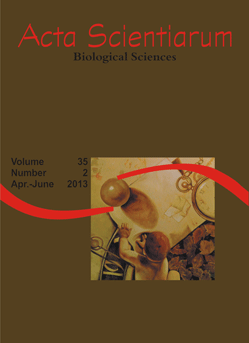<b>Reproductive strategies of fish populations from three Neotropical streams</b> - doi: 10.4025/actascibiolsci.v35i2.10932
Abstract
This study aimed to characterize the reproductive strategies of fish from first order streams. Samplings were performed every three months from June 2008 to March 2009, using electric fishing at three streams: Conceição, Scherer and Jurema, located in the municipalities of Diamante do Norte and Amaporã, Paraná State, Brazil. We obtained the total weight (g), standard or total length (cm), sex and maturation stage for each specimen. Limnological data were obtained with portable equipments. The minimum length at first maturation was established for each population, and reproduction period was determined by analyzing the distribution of maturation stages. The sex ratio was obtained and tested (X2) for significant differences. Eight species were analyzed and they responded differently to environmental pressures, reflected in the ratio between males and females, and in different reproductive strategies adopted. The streams were used as spawning ground in September and rest and recruitment areas in December and March, due to changes in the limnological parameters that signalize favorable periods for reproduction. We conclude that the protection provided by preserved riparian vegetation encourage the uptake of food by fishes and maintain their general physical characteristics, promoting the diversification in tactics found.Downloads
Download data is not yet available.
Published
2012-12-20
How to Cite
Zanatta, N., Cionek, V. de M., & Benedito, E. (2012). <b>Reproductive strategies of fish populations from three Neotropical streams</b> - doi: 10.4025/actascibiolsci.v35i2.10932. Acta Scientiarum. Biological Sciences, 35(2), 185-194. https://doi.org/10.4025/actascibiolsci.v35i2.10932
Issue
Section
Ecology and Limnology
DECLARATION OF ORIGINALITY AND COPYRIGHTS
I Declare that current article is original and has not been submitted for publication, in part or in whole, to any other national or international journal.
The copyrights belong exclusively to the authors. Published content is licensed under Creative Commons Attribution 4.0 (CC BY 4.0) guidelines, which allows sharing (copy and distribution of the material in any medium or format) and adaptation (remix, transform, and build upon the material) for any purpose, even commercially, under the terms of attribution.
Read this link for further information on how to use CC BY 4.0 properly.
0.6
2019CiteScore
31st percentile
Powered by 

0.6
2019CiteScore
31st percentile
Powered by 











1.png)




3.png)













